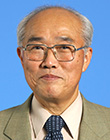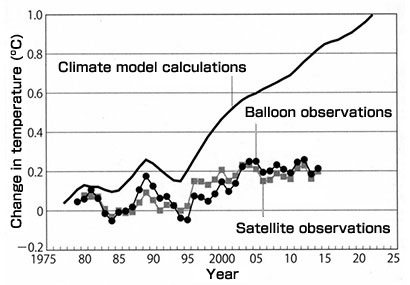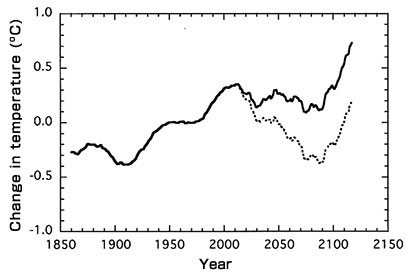Top>Opinion>No more global warming
 Index
Index

Yuh Fukai【profile】
No more global warming
Yuh Fukai
Professor Emeritus, Faculty of Science and Engineering, Chuo University
Areas of Specialization: Metal Physics, Materials Science, Earth Sciences
Failure of the CO2 warming hypothesis

Figure 1. Average global temperatures since 1979: Observed versus projections based on CO2-driven global warming models (Christy 2015)
The United Nations is spearheading a campaign to stop global warming driven by increasing carbon dioxide levels, and a massive amount of funding is being poured into the effort. During November - December this year, it will host the COP21 United Nations Conference on Climate Change in Paris to discuss future strategies for coping with global warming, and the Japanese government has expressed its desire to take a leading role in the talks. Japan spends some three to four trillion yen a year on measures to fight global warming, and if you take into account the 1–2% shrinkage in GDP that these measures cause in terms of lost profits, you’re left with a cost of some 200,000 yen per Japanese household. The media continue to insist that this is not enough, however, implying that Japan should take a still more prominent role.
We often hear of global temperatures rising by two or four degrees centigrade over the next hundred years, despite the fact that hardly any actual warming data has been reported. Is this supposedly self-evident global warming even occurring?
There’s no doubt that the temperature of the earth has been gradually rising over the last hundred years, but that increase has actually stopped dead over the past eighteen years. Figure 1 shows the most recent data as compiled by the American climate scientist John Christy, who presented it to the House Committee on Natural Resources in May 2015. The global data sets from weather balloons and satellites are a close match, and show that temperatures generally peaked around 1998 and, if anything, have been falling as of late. Meanwhile, projections from more than 100 groups around the world whose calculations come from a CO2-driven global warming model show a steady increase in temperature following increasing carbon dioxide levels—projections that grow farther removed from the actual observed data each year. Put simply, the CO2-driven global warming hypothesis has fallen apart.
The Intergovernmental Panel on Climate Change (IPCC) publishes a report every few years containing its global warming assessments. Though the panel maintains that CO2-driven global warming poses a growing threat year after year, confusion has arisen with their Fifth Assessment Report (2014–2015) as a result of glaring discrepancies between the group’s calculations and observed data. The entire report spans thousands of pages, with the IPCC mentioning the fact that its calculations don’t match real-world observations in part one, The Physical Science Basis, where it states that the reason for the inconsistency is unknown. However, it proceeds to keep the inconsistencies under wraps in parts two (Impacts, Adaptation, and Vulnerability) and three (Mitigation of Climate Change), continuing to base its arguments entirely on its CO2-driven global warming calculations. The thirty-page “Summary for Policymakers” presented at the beginning of the report makes no mention of the failures of the CO2-driven global warming hypothesis—and even goes so far as to claim that human-caused global warming is an undeniable fact. This is clearly a contradiction. It is not without reason to assume that the IPCC intentionally hid the model’s failure, anticipating that the majority of readers will likely go no further than the Summary.
News of all kinds of threats continues to spread on the assumption that CO2-driven global warming will persist. Sea levels will rise as higher temperatures begin melting the Antarctic ice sheet, for example, submerging Tuvalu, the Maldives, and other coral island nations. But this is simply not true. Glacial tips breaking off into the ocean is a natural process caused by the slow movement of inland snowfall solidified into glaciers and eventually making its way to the sea. It has nothing to do with rising earth temperatures. And satellite data indicate that the surface area of the Antarctic glacier is actually increasing. Estimates that sea levels will rise 50–100 centimeters over the next hundred years have no basis in reality. Actual observations indicate a rise of around 20 centimeters over the past century—and no more than 5 cm in Japan. And because coral organisms grow by just barely extending themselves above the water surface, it’s only natural that coral reefs should maintain a low elevation—and that they have managed to keep pace with the 100-meter rise in sea levels that has taken place over the past several thousands of years. Put simply, the very nature of coral reefs makes it impossible for them to sink.
Now let’s turn to the matter of the two-degree target. We’re meant to stop global warming at this level based on the fear that if the atmospheric temperature rises more than two degrees above pre-Industrial Revolution levels, it will be too late to save the planet. But the scientific evidence for this claim is extremely scant. The person who originally put forth this target, Hans Schellnhuber from the Potsdam Institute for Climate Impact Research, has acknowledged that his figure is no more than a rough guideline. “We can't exactly drop 10,000 studies from Science and Nature on our political leaders’ desks,” he admits. “They need a simple target.” Schellnhuber also serves as a scientific advisor to Chancellor Merkel, and even appealed to the Pope to write in his encyclical to the world’s Catholic bishops that global warming is a serious threat and that we must take action to stop it. Meanwhile, other German climate scientists have issued stern rebukes to Schellnhuber for pulling publicity stunts like these in the name of science.
The two-degree target is scientific nonsense, given that paleoclimatology studies clearly show the earth going through much larger temperature variations over the past 100,000 years with repeated ice ages and interglacial periods. The earth’s climate system has tremendous power of restitution.
The sun determines the climate

Figure 2. Temperature changes over the last 150 years and estimates for the next 100 years based primarily on solar activity (Fukai et al 2015)
Atmospheric CO2 concentration has risen sharply since the Industrial Revolution, but global temperatures have been fluctuating significantly since well before then. If we look at temperature changes over the last two thousand years, we find them peaking during the medieval warm period around 1000 AD and reaching a low during the little ice age/Maunder period somewhere around the year 1700 AD. Current temperatures have again risen to about where they were during the medieval warm period, and are now leveling off. The Maunder period was actually characterized by large temperature fluctuations with repeated onslaughts of very cold periods as clearly described in various historical records.
Scientists have long known that the data show a strong correlation between climate change and the number of sunspots (a measure of solar activity), though we are only now beginning to understand the mechanism by which solar activity impacts the earth’s climate thanks to recent advances in solar and interplanetary space physics.
Just as a period of intense solar activity is ending and shifting to a quieter period reminiscent of the Maunder, people began to consider that this decreased solar activity is the cause of the leveling off of the temperature increases tracked over the last 300 years. Several solar scientists are now predicting that solar activity levels during 2030–2040 will cause temperatures to dip once again.
Figure 2 shows our temperature predictions based on the assumption of a second Maunder period. Because past solar activity has been recorded in terms of fluctuations in the intensity of cosmic rays, we can extrapolate the data to come up with estimates for future levels. The dotted prediction curve below assumes that carbon dioxide concentration will stay fixed at its current value, while the solid curve above assumes that it will increase. The estimates for CO2-driven global warming assume the moderate emission speed adopted by the IPCC in their Fifth Assessment Report. The temperature drop that accompanies a reduction in solar activity is quite significant, so although CO2-driven global warming may partially counteract it, the cooling trend is likely to continue largely unchanged over the next hundred years. The significant warming that the IPCC proposes is hardly thinkable. What we need to be doing is preparing to be revisited by the kind of bitter cold that characterized the Maunder period.
What’s next
Many meteorologists and climatologists in Japan are content to cling to the CO2-driven global warming hypothesis despite its inconsistencies, and the majority of the Japanese people are convinced that CO2-driven global warming is taking place. In the United States and Europe, however, we’re seeing a sharp drop in the number of people that believe in human-caused global warming as temperature stabilization and the repeated IPCC scandals become more widely known. The percentage of Americans who agree with the prediction of global-warming threat dropped to just 24% in 2014 according to the Gallup polls. A wide gap of recognition is emerging between Japan and many other developed countries
There are two fundamental concepts that we need to be aware of going forward. The first is that atmospheric carbon dioxide poses no harm—and if anything is beneficial as it is an essential component in healthy plant growth. The second is that reducing carbon dioxide emissions is a critical task not to stop global warming but to conserve our precious carbon resources for future generations. Making carbon dioxide emissions themselves the enemy has twisted our energy policies and resulted in the world spending what is probably twenty trillion yen a year on measures to stop global warming—money that could surely be better spent fighting poverty or health epidemics. Another critical thing to remember is that global cooling is now being predicted as a result of decreased solar activity—and it’s happing now, not a hundred years down the road. The science and politics of global warming are about to be turned completely upside down.
I hope you’ve learned something about the science of global warming. If you would like to know more about this issue, including the politics involved, I recommend my publications Climate Change and Energy Issues [Kiko Hendo to Enerugi Mondai] (Chuko Shinsho, 2011) and The Globe Isn’t Warming Anymore [Chikyu wa Mou Ondanka Shiteinai] (Heibonsha Shinsho, 2015).
-
Yuh Fukai
Professor Emeritus, Faculty of Science and Engineering, Chuo University Areas of Specialization: Metal Physics, Materials Science, Earth Sciences -
Professor Fukai was born in Chiba Prefecture in 1934. He graduated from the Department of Physics, Faculty of Science, the University of Tokyo in 1958 with a major in geophysics. In 1963, he received his Doctor of Science for completing the doctorate program at the university’s Graduate School of Science. He worked as a full-time instructor, associate professor, and professor at Chuo University before retiring in 2005 and being awarded the title of Professor Emeritus. Dr. Fukai currently works as a visiting researcher at the Institute of Materials Structure Science and the Institute of Industrial Science, the University of Tokyo. Though he specializes in materials science as well as in metal physics (with a particular focus on the physical properties of metal-hydrogen systems), he also has interest in earth sciences as well as climate change and energy issues.
His primary works include The Physics of Diffusion Phenomena [Kakusan Gensho no Butsuri] (Asakura Shoten, 1988), Hydrogen and Metals [Suiso to Kinzoku] (Uchida Rokakuho, 1998), The Metal-Hydrogen System (Springer, 2005), Climate Change and Energy Issues [Kiko Hendo to Enerugi Mondai] (Chuko Shinsho, 2011), and The Globe Isn’t Warming Anymore [Chikyu wa Mou Ondanka Shiteinai] (Heibonsha Shinsho 2015).
- Research Activities as a Member of Research Fellowship for Young Scientists (DC1), Japan Society for the Promotion of Science (JSPS) Shuma Tsurumi
- Important Factors for Innovation in Payment Services Nobuhiko Sugiura
- Beyond the Concepts of Fellow Citizens and Foreigners— To Achieve SDGs Goal 10 “Reduce Inequality Within and Among Countries” Rika Lee
- Diary of Struggles in Cambodia Fumie Fukuoka
- How Can We Measure Learning Ability?
—Analysis of a Competency Self-Assessment Questionnaire— Yu Saito / Yoko Neha - The Making of the Movie Kirakira Megane








